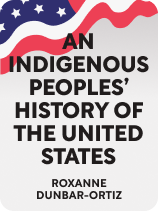

This article is an excerpt from the Shortform book guide to "An Indigenous Peoples' History of the United States" by Roxanne Dunbar-Ortiz. Shortform has the world's best summaries and analyses of books you should be reading.
Like this article? Sign up for a free trial here.
What are key Native American struggles today? How are indigenous people fighting for justice in the 21st century?
Native American struggles today are focused on the right to self-determination—for example, the right to independent governing bodies. Many see the current US policies as a continuation of the genocide at the foundation of the country.
Here are some of the ways that Native Americans are still fighting for their rights.
Native Americans in the 21st Century
Despite Native Americans’ resistance during the Civil Rights era, the US has continued its attempt to suppress Native American populations into the 21st century. Native American struggles today include cultural preservation versus assimilation. For example, some politicians want to abolish the reservation system, which would result in full-scale assimilation and the loss of Native American cultures. However, indigenous resistance efforts also continue.
The primary concern of contemporary native activists is self-determination—the right of native nations to act autonomously within the US system or else to withdraw as independent nations. Native activists are also trying to get reparations (amends for harm done by the US). This involves enforcing preexisting treaties and securing the return of sacred lands like the Black Hills (where Mount Rushmore is carved) and their ancestors’ remains and artifacts from museums. Activists also want economic independence, which they believe will help cure high rates of social ills like alcoholism, suicide, and sexual violence.
Achieving these ends is key to a more peaceful future—not only for Native Americans but also for the world. The US continues to carry out imperialist projects abroad (for example, in the Middle East); recall that modern imperialism replicates the genocidal tactics the US has used against Native Americans. If the US can learn from its mistakes, make amends, and change its ways, the future will be better for everyone.
| How Genocide and Resistance Continue in the 21st Century The pattern of US-perpetrated genocide and Native American resistance continues in the 21st century in many ways—let’s explore how this occurs in greater detail. One way the US attempts to suppress Native American life today is by challenging the reservation system. For example, Montana Republican Keith Regier proposed in 2023 that Congress explore alternatives to the system because, in his opinion, reservations are unconstitutionally race-based. Native American officials responded that Regier’s proposal relied on racist stereotypes and would pose a threat to indigenous sovereignty. Ultimately, Regier chose not to introduce the legislation, after an indigenous lawmaker, Shane Morigeau, shared his opposing views with Regier. Other issues include the return of sacred land like Black Hills as well as the belongings and remains of indigenous ancestors. The return of Black Hills to the Sioux may be unlikely because Mount Rushmore is a profitable tourist attraction, but that fight is ongoing—and some native activists have advocated that the attraction be transformed into a genocide museum. Investigative journalists noted in 2023 that despite a 1990 federal law, many museums have yet to repatriate the remains and artifacts of indigenous peoples to their descendants. Another way Native Americans say the US suppresses indigenous life in the 21st century is via environmental injustice, which includes catastrophes like oil spills and wildlife extinction. Native American resistance continues in this realm as well—for example, the Standing Rock Sioux engaged in civil disobedience against the 2016 construction of the Dakota Access Pipeline, which the activists argued violated an 1868 treaty and endangered both the environment and ancestral remains. Some economists agree that self-determination is key to alleviating poverty among Native American peoples, arguing that US supervision over indigenous affairs prevents Native Americans from making profits and using money efficiently. Since poverty is linked to the exacerbation of substance abuse, higher risk of mental illness and suicide, and more sexual violence, these economists say that self-sovereignty might help cure high rates of social ills among Native Americans. Activists are also using other methods to attack these problems—for example, the Missing and Murdered Indigenous Women (MMIW) movement aims to secure resources for indigenous victims of violence against women. Finally, the US continues to carry out colonialist/imperialist projects abroad, specifically in the Middle East. Some global human rights experts support this argument. For example, Amnesty International says the US committed numerous war crimes and human rights violations throughout the Iraq War, during which the US occupied Iraq, ostensibly with the aim of “modernizing” the nation (which echoes the historic justification for boarding schools for native children and other anti-indigenous policies). Additionally, some argue that the US is guilty of colonialism by proxy since it provided Israel with weapons that were potentially used in the commission of war crimes against the Palestinian people. |

———End of Preview———
Like what you just read? Read the rest of the world's best book summary and analysis of Roxanne Dunbar-Ortiz's "An Indigenous Peoples' History of the United States" at Shortform.
Here's what you'll find in our full An Indigenous Peoples' History of the United States summary:
- A retelling of US history from a Native American perspective
- What led Europe to colonize the Americas
- How patterns of genocide and resistance have played out over the course of US history






